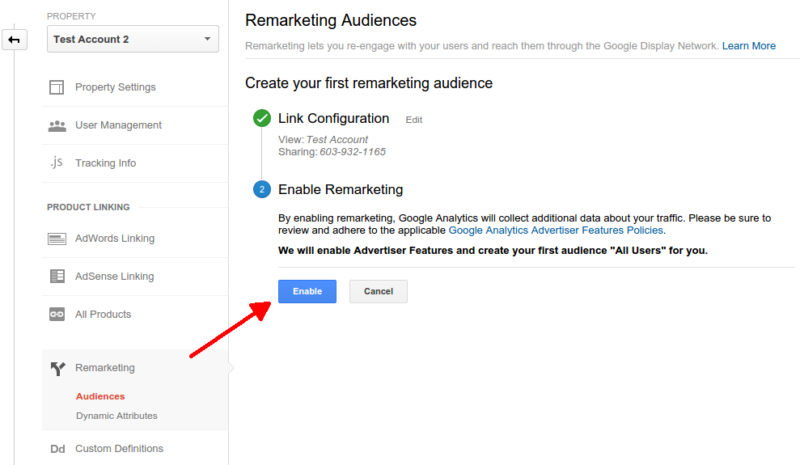Maximize Your ROI With Remarketing in Google Analytics
In the world of digital marketing, the use of remarketing methods within Google Analytics has proven to be a powerful device for enhancing return on financial investment. By utilizing the power of individual data and tailoring ads to particular audience sections, organizations can dramatically intensify their conversion rates. The genuine essential lies in the art of precision - comprehending customer actions, crafting compelling advertisements, and constantly refining techniques to drive optimal results. The trip to making the most of ROI via remarketing is a nuanced path paved with understandings and chances that can reshape the trajectory of your advertising and marketing ventures.
Comprehending Remarketing in Google Analytics
Comprehending remarketing in Google Analytics is important for maximizing your electronic advertising and marketing approach. Remarketing permits you to target users who have actually previously seen your web site or connected with your app, providing them with customized advertisements as they browse other sites or use various other apps within the Google Present Network. This strategy assists maintain your brand top of mind and encourages customers to return to your site, ultimately boosting the possibility of conversion.
By making use of Google Analytics, you can track the performance of your remarketing campaigns, obtaining valuable understandings into customer habits, engagement, and conversions. This information allows you to fine-tune your targeting, messaging, and bidding process methods to enhance the overall effectiveness of your campaigns.
In addition, recognizing the different types of remarketing checklists available in Google Analytics, such as conventional, vibrant, and comparable audiences, allows you to create extremely fractional and tailored campaigns customized to details user segments. This level of granularity can significantly improve the importance and impact of your remarketing initiatives, inevitably maximizing your roi.
Establishing Up Remarketing Listings
To effectively apply remarketing projects in Google Analytics, the initial action involves setting up and producing remarketing listings targeting certain individual sections based upon their communications with your internet site or application. By establishing up remarketing checklists, you can customize your advertising initiatives to reach customers who have actually currently revealed interest in your solutions or items.
To start, browse to the Admin area of your Google Analytics account and choose the Building where you intend to produce the remarketing checklist. After that, under the Home column, click 'Target market Definitions' and choose 'Target markets.' Next, click on the red 'New Target market' button and select 'Produce New' to specify the specifications for your remarketing checklist.

Crafting Effective Remarketing Ads

When crafting your advertisements, concentrate on producing eye-catching headings and engaging visuals that attract attention to possible customers. Incorporate strong calls-to-action that motivate users to revisit your site and complete a wanted activity. Make use of vibrant remarketing to reveal tailored advertisements featuring services or products that users website link have actually formerly watched on your website.
Furthermore, guarantee that your ads are mobile-friendly since a substantial section of web traffic originates from smart phones. Examination various advertisement variants to determine which messages and styles drive the most effective outcomes. By continuously refining and enhancing your remarketing advertisements based upon performance data, you can maximize their performance and improve your return on investment.
Analyzing Remarketing Performance

Through Google Analytics, marketing experts can track the efficiency of their remarketing projects in real-time, allowing them to identify patterns, patterns, and areas for improvement promptly. By examining the data, marketing professionals can identify which ads are carrying out well, which audience segments are responding positively, and which networks are driving the most conversions. This degree of granularity makes it possible for online marketers to why not find out more make data-driven choices to optimize their remarketing advocate much better results.
Maximizing ROI With Remarketing
Examining remarketing data in Google Analytics enables marketing experts to identify possibilities for maximizing return on investment (ROI) through tactical changes - What Is “Remarketing” In Google Analytics?. To optimize ROI with remarketing, it is essential to recognize the behavior of your target market. By examining user communications, such as the pages they saw, the items they viewed, or the actions they tackled your site, you can customize your remarketing projects better
Segmenting your audience based on their actions enables you to produce customized and targeted advertisements that are more probable to reverberate with them. By showing relevant advertisements to details sectors of your audience, you can increase the possibilities of conversion and eventually enhance your ROI.
Furthermore, examining various advertisement creatives, messaging, and deals can aid identify what resonates ideal with your audience. A/B screening allows you to explore various components of your ads to establish what drives the highest involvement and conversion rates.
Verdict
To conclude, taking full advantage of ROI with remarketing in Google Analytics needs a strategic method to examining customer actions, segmenting audiences, developing customized advertisements, and enhancing campaign performance. By leveraging data-driven understandings and checking various techniques, organizations can enhance their remarketing initiatives to drive higher engagement and conversion rates. This systematic method makes certain that resources are efficiently allocated in the direction of making the most of returns find out here now on investment in remarketing projects.
Next, click on the red 'New Target market' button and choose 'Develop New' to define the parameters for your remarketing checklist.
By constantly refining and maximizing your remarketing ads based on efficiency data, you can optimize their efficiency and enhance your return on investment.
By delving into these understandings, marketing experts can obtain an extensive understanding of exactly how their remarketing initiatives are resonating with their target audience and driving conversions. To take full advantage of ROI with remarketing, it is essential to comprehend the actions of your target market.In verdict, optimizing ROI with remarketing in Google Analytics requires a calculated approach to assessing user behavior, segmenting audiences, producing tailored advertisements, and optimizing campaign performance.